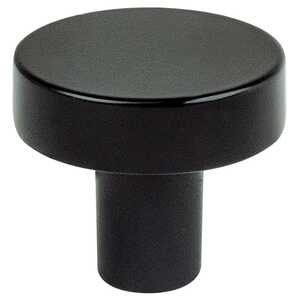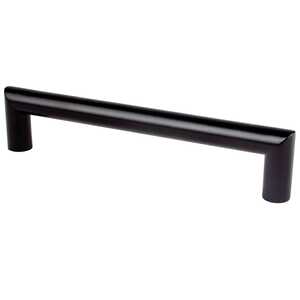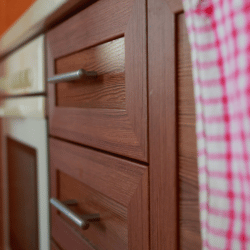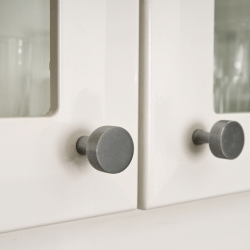Knobs vs. Pulls on Kitchen Cabinet Doors

Cabinet hardware, primarily knobs and pulls, is essential for the functionality of your kitchen doors and drawers. Beyond their practical use, they also enhance the aesthetics of your cabinets. While they might be crafted from identical materials and finishes, each possesses a distinct character.
In this guide, we’ll teach you the main differences between cabinet pulls and knobs, so you can decide which is best for your next home renovation project.
Cabinet Knobs

Cabinet knobs are typically round metal handles with a diameter of about an inch. While they can lend a classic and intricate touch, they can also embody a sleek, modern design.
The optimal placement for cabinet knobs is near the door corners, positioned roughly one to two inches from each edge. Nevertheless, based on the door's design, you can choose to fix the knob at the frame's corner or the inset panel's corner. For drawers, centering the knob ensures a harmonious look.
Cabinet Pulls

Cabinet pulls, on the other hand, resemble handles with two connecting points and a bar in between. While many pulls sport a streamlined, rectangular shape, suitable for a minimalist aesthetic, others can be curved or feature intricate details.
Given their design, cabinet pulls allow for a firmer grip, making them convenient to use, especially for those who find grasping objects challenging.
For optimal aesthetics, it's advisable to place cabinet handles at the lower corner of a door or the upper corner if the cabinet is below a countertop. Regarding drawers, the pulls can be centered on the middle panel or aligned with the drawer's top edge.
Knobs vs. Pulls: Which One to Choose?

The selection between cabinet pulls vs. knobs is mainly subjective, hinging on individual tastes. Nonetheless, several factors can guide your choice.
Kitchen Style & Design
- Traditional Feel: If you're leaning towards a timeless or classic ambiance, knobs might be your best bet. They exude warmth, evoking images of country or farmhouse kitchens. Moreover, they pair well with subdued metallic finishes.
- Contemporary Look: Modern kitchen designs often mesh seamlessly with cabinet pulls. Sleek, straight-line pulls impart a neat, uncluttered feel. However, rounded pulls might also fit into more rustic kitchen themes.
Types of Cabinet Door Style
- Detailed Doors: Intricate designs like Arched Cabinet Doors or French-Lite Glass Ready Doors gain an added charm with ornate knobs.
- Simplified Doors: The clean lines of edge-banded slab cabinet doors stand out with cabinet pulls. In contrast, the versatile Shaker-style doors are amenable to both knobs and pulls.
Practicality and Comfort
For some, functionality is a bigger factor than style. Pulls are a safer bet if your household includes children or seniors who may struggle with grip. Their design, which permits grasping with multiple fingers, ensures a firm hold. On the flip side, knobs, being compact, might be slippery and harder to hold. Nonetheless, knobs are more suitable for overhead cabinets as they're easier to grasp when reaching out.
Explore the Materials and Finishes
When searching for cabinet knobs or pulls, it's important to consider the material and finish. The material and finish determine the aesthetic of the hardware, and you want to ensure the style complements your vision for your space. Popular finishes to consider include:
- Matte Black: Matte black offers a timeless aesthetic, perfect for modern, contemporary, or bold kitchen designs. This finish is also great for adding contrast to modern, all-white kitchens.
- Satin Champagne: This warm and inviting color pairs well with navy blue, white, sage, or dark-colored cabinet doors. It is a top choice for traditional and vintage campaigns.
- Satin Nickel: Satin Nickel is a silvery chrome that pairs well with chrome appliances and hardware. This is a versatile color choice that can complement various colors and natural wood finishes.
Materials that are available for cabinet knobs and pulls at Cabinet Door Factory include:
- Steel: High-quality option less resistant to rust or general wear and tear.
- Zinc: Budget-friendly alternative with a high-end feel.
Other popular materials for cabinet pulls and knobs include chrome, wood, brass, and bronze.
Cost Comparison

The cost for the knobs and pulls will widely depend on the style, material, and finish. Cabinet door knobs tend to be more affordable than cabinet door pulls, which is something to keep in mind if you have a relatively large kitchen or bathroom.
For most knobs, you can expect to pay around $5-$7 for each knob. While pulls are around $10-12. While the cost difference may not be drastically different, the cost can add up if you have a larger space. It's best to count up how many pulls or knobs you need for your project, so you can compare the general print points between the two.
Installation Considerations
The installation process for cabinet pulls and knobs can also vary, which is something to consider, especially if you've never installed cabinet door hardware yourself.
Knobs are relatively quick and easy to install. In most cases, you'll only need one screw to install them to your cabinet doors or drawer fronts. While cabinet door pulls are a bit more complex. With this installation, you'll need to know how to align the pulls to be level. You'll also need at least two screws to install them.
Save Big With Cabinet Door Factory
Your choice of vendor significantly influences the cost when replacing cabinet doors. By choosing the Cabinet Door Factory, you stand to save 30-50% compared to conventional retail prices. We take pride in providing top-tier, tailored replacement cabinet doors at rates typically available to distributors. Plus, enjoy hassle-free delivery right to your doorstep!
Explore our cabinet door hardware today.
Frequently Asked Questions
Can you mix knobs and pulls?
Mixing knobs and pulls on kitchen cabinets is an excellent way to add to the atmosphere of your kitchen and include some added flavor to the design. A great opportunity to incorporate this strategy is to use knobs on the cabinets while using pulls on the drawers. Alternatively, you can use knobs for cabinets above the counters while using pulls for those below. This helps you to be consistent while still mixing things up.
How to choose kitchen cabinet knobs and pulls?
Always consider the aesthetic and functionality of your space. The hardware you choose should complement your kitchen theme, cabinet door size, style, and functionality.
Where to place knobs and pulls on kitchen cabinets?
Cabinet hardware is designed to be installed on the opposite side of the door hinge. The exact measurements or placement may vary depending on your cabinet door or drawer front size. As a rule of them, knobs should typically be installed 2-½” to 3” above the bottom of the cabinet door. While cabinet door pulls should be installed using the 1/3 rule. The 1/3 rule says the pulls should be placed 1/3 the height and 1/3 the width.
How to install knobs and pulls on kitchen cabinets?
To install your pulls and knobs, you'll need screws, a drill, and a level. You'll want to start by marking the holes for the screws and drilling in the holes in the exact place. The manufacturer you purchase the knobs and pulls from should provide further instructions.


